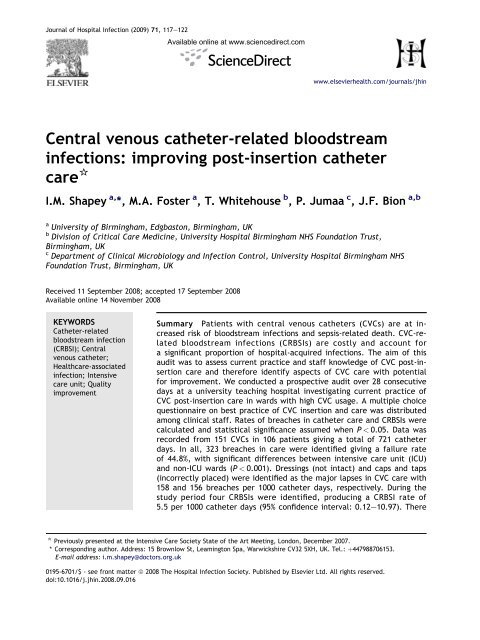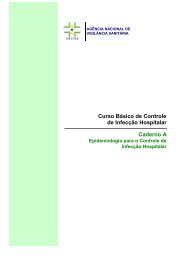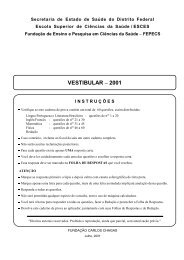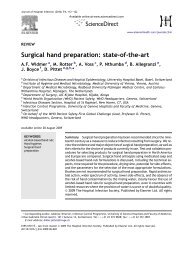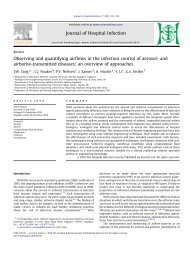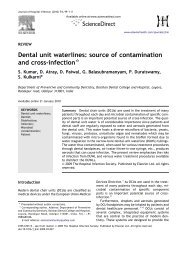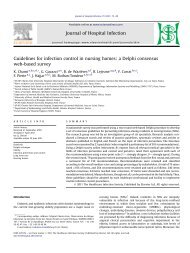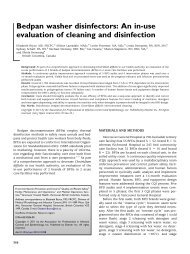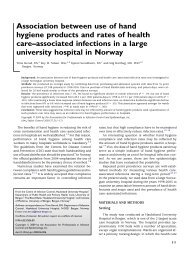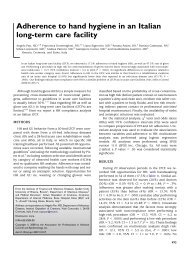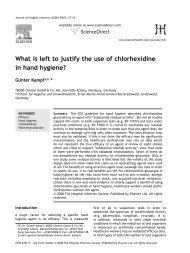Central venous catheter-related bloodstream infections ... - CCIH
Central venous catheter-related bloodstream infections ... - CCIH
Central venous catheter-related bloodstream infections ... - CCIH
You also want an ePaper? Increase the reach of your titles
YUMPU automatically turns print PDFs into web optimized ePapers that Google loves.
Journal of Hospital Infection (2009) 71, 117e122<br />
<strong>Central</strong> <strong>venous</strong> <strong>catheter</strong>-<strong>related</strong> <strong>bloodstream</strong><br />
<strong>infections</strong>: improving post-insertion <strong>catheter</strong><br />
care *<br />
I.M. Shapey a, *, M.A. Foster a , T. Whitehouse b , P. Jumaa c , J.F. Bion a,b<br />
a<br />
University of Birmingham, Edgbaston, Birmingham, UK<br />
b<br />
Division of Critical Care Medicine, University Hospital Birmingham NHS Foundation Trust,<br />
Birmingham, UK<br />
c<br />
Department of Clinical Microbiology and Infection Control, University Hospital Birmingham NHS<br />
Foundation Trust, Birmingham, UK<br />
Received 11 September 2008; accepted 17 September 2008<br />
Available online 14 November 2008<br />
KEYWORDS<br />
Catheter-<strong>related</strong><br />
<strong>bloodstream</strong> infection<br />
(CRBSI); <strong>Central</strong><br />
<strong>venous</strong> <strong>catheter</strong>;<br />
Healthcare-associated<br />
infection; Intensive<br />
care unit; Quality<br />
improvement<br />
Available online at www.sciencedirect.com<br />
www.elsevierhealth.com/journals/jhin<br />
Summary Patients with central <strong>venous</strong> <strong>catheter</strong>s (CVCs) are at increased<br />
risk of <strong>bloodstream</strong> <strong>infections</strong> and sepsis-<strong>related</strong> death. CVC-<strong>related</strong><br />
<strong>bloodstream</strong> <strong>infections</strong> (CRBSIs) are costly and account for<br />
a significant proportion of hospital-acquired <strong>infections</strong>. The aim of this<br />
audit was to assess current practice and staff knowledge of CVC post-insertion<br />
care and therefore identify aspects of CVC care with potential<br />
for improvement. We conducted a prospective audit over 28 consecutive<br />
days at a university teaching hospital investigating current practice of<br />
CVC post-insertion care in wards with high CVC usage. A multiple choice<br />
questionnaire on best practice of CVC insertion and care was distributed<br />
among clinical staff. Rates of breaches in <strong>catheter</strong> care and CRBSIs were<br />
calculated and statistical significance assumed when P < 0.05. Data was<br />
recorded from 151 CVCs in 106 patients giving a total of 721 <strong>catheter</strong><br />
days.Inall,323breachesincarewereidentifiedgivingafailurerate<br />
of 44.8%, with significant differences between intensive care unit (ICU)<br />
and non-ICU wards (P < 0.001). Dressings (not intact) and caps and taps<br />
(incorrectly placed) were identified as the major lapses in CVC care with<br />
158 and 156 breaches per 1000 <strong>catheter</strong> days, respectively. During the<br />
study period four CRBSIs were identified, producing a CRBSI rate of<br />
5.5 per 1000 <strong>catheter</strong> days (95% confidence interval: 0.12e10.97). There<br />
* Previously presented at the Intensive Care Society State of the Art Meeting, London, December 2007.<br />
* Corresponding author. Address: 15 Brownlow St, Leamington Spa, Warwickshire CV32 5XH, UK. Tel.: þ447988706153.<br />
E-mail address: i.m.shapey@doctors.org.uk<br />
0195-6701/$ - see front matter ª 2008 The Hospital Infection Society. Published by Elsevier Ltd. All rights reserved.<br />
doi:10.1016/j.jhin.2008.09.016
118 I.M. Shapey et al.<br />
Introduction<br />
<strong>Central</strong> <strong>venous</strong> <strong>catheter</strong>s (CVCs) are vascular infusion<br />
devices used for monitoring haemodynamic<br />
variables, renal replacement therapy and the<br />
administration of medication. The invasive nature<br />
of indwelling intravascular <strong>catheter</strong>s predisposes<br />
the patient to a host of possible complications.<br />
Such complications can arise from the individual<br />
characteristics of each patient (e.g. difficulty in<br />
accessing subclavian or internal jugular veins) and<br />
may include mechanical complications (e.g. pneumothorax,<br />
haematoma, and arterial puncture),<br />
thrombotic and infectious complications. 1e5<br />
Healthcare-associated infection is a major cause<br />
of morbidity and mortality. 6 Patients with CVCs are<br />
at markedly increased risk of <strong>bloodstream</strong> <strong>infections</strong><br />
and sepsis-<strong>related</strong> death. 7 It is estimated<br />
that up to 6000 patients in England per year may acquire<br />
a <strong>catheter</strong>-<strong>related</strong> <strong>bloodstream</strong> infection<br />
(CRBSI). 8 Treatment costs of such <strong>infections</strong> are estimated<br />
to exceed £6000 per infection. 9<br />
The National Audit Office (NAO) report in 2000<br />
on the control of hospital-acquired infection highlighted<br />
the need for improved education, training<br />
and audit of compliance with infection control<br />
guidelines. 10 The National Institute for Clinical Excellence<br />
issued guidelines in 2003 for the prevention<br />
of healthcare-associated infection. 11 Best<br />
practice in the use of CVCs incorporates the use<br />
of maximal sterile barrier precautions during <strong>catheter</strong><br />
placement; highest standards of hand hygiene;<br />
2% chlorhexidine gluconate for skin<br />
antisepsis; regular inspection of CVC insertion sites<br />
(dressings); documentation of CVC insertion and<br />
removal dates; maintaining closed systems (caps<br />
and taps closed); removal of CVCs if signs of infection<br />
are present and saline flushing of <strong>catheter</strong><br />
lumens.<br />
The aim of this study was to audit current<br />
standards of practice in CVC maintenance in<br />
high-use wards of a university teaching hospital,<br />
assess knowledge of standards of CVC care<br />
amongst staff in high-use wards and therefore<br />
identify aspects of CVC care with the potential<br />
for improvement.<br />
are several opportunities to improve CVC post-insertion care. Future interventions<br />
to improve reliability of care should focus on implementing<br />
best practice rather than further education.<br />
ª 2008 The Hospital Infection Society. Published by Elsevier Ltd. All rights<br />
reserved.<br />
Methods<br />
Study setting and design<br />
The study took place during one month in 2007 at<br />
the Queen Elizabeth Hosptial, a tertiary referral<br />
hospital in Birmingham. Clinical areas with the<br />
greatest use of CVCs were identified using hospital<br />
data on numbers of CVCs purchased.<br />
A prospective audit of current standards of CVC<br />
care was undertaken in these high-use clinical<br />
areas. Staff knowledge of standards of best practice<br />
in CVC care was assessed in the same areas<br />
over the same period using a questionnaire.<br />
Catheter care<br />
The standard of post-insertion care of CVCs in<br />
patients in high-use areas was audited over 28<br />
consecutive days. Assessments were made once<br />
daily, and based upon current evidence-based<br />
guidelines and UK Department of Health recommendations;<br />
they included inspection of CVC caps<br />
and taps, dressings, <strong>catheter</strong> insertion sites and<br />
lumens. 11,12 A breach in care was defined as a lapse<br />
in optimal <strong>catheter</strong> care for any amount of time during<br />
a 24 h period. Optimal care included: caps and<br />
taps correctly placed, dressing intact, lumens<br />
flushed and no signs of infection at the <strong>catheter</strong> site.<br />
Results of all blood samples and <strong>catheter</strong> tips<br />
sent for culture were recorded for patients with<br />
a CVC during the 28 day study period. CRBSI was<br />
defined as bacteraemia/fungaemia in a patient<br />
with an intravascular <strong>catheter</strong> with the same<br />
organism identified at both blood and CVC tip<br />
culture, clinical manifestations of infection (i.e.<br />
chills, fever, and/or hypotension), and no apparent<br />
source for the <strong>bloodstream</strong> infection except<br />
the <strong>catheter</strong>. Bloodstream <strong>infections</strong> were considered<br />
to be associated with a central line if the line<br />
had been in use during the 48 h period before the<br />
development of the <strong>bloodstream</strong> infection. We<br />
justify using this definition on the basis that, as<br />
an observational study, we had no standardised<br />
or mandated method for CVC tip and blood<br />
cultures.
<strong>Central</strong> <strong>venous</strong> <strong>catheter</strong> post-insertion care 119<br />
Staff survey<br />
A questionnaire was distributed to staff working in<br />
the high-use clinical areas on an opportunistic<br />
basis. Knowledge of best practice of <strong>catheter</strong><br />
insertion and post-insertion care was assessed<br />
using multiple choice questions. All grades of<br />
nurses and doctors were approached during the<br />
study period to complete the one-page<br />
questionnaire.<br />
Data and statistical analysis<br />
We chose to restrict identifying opportunity for<br />
failure (breaches) in care to a once daily visit.<br />
Reliability rates (rates of breaches) for <strong>catheter</strong><br />
care and CRBSIs were calculated per 1000 <strong>catheter</strong><br />
days. Chi-squared analysis was used to compare<br />
rate of breaches between clinical areas, according<br />
to median duration ( 4 days and >4 days), and<br />
between culture-positive and culture-negative<br />
CVCs. P < 0.05 was considered to be statistically<br />
significant.<br />
Results<br />
We identified five wards in our hospital with high<br />
CVC use: two general surgical wards with designated<br />
four-bedded post-operative areas (Surg 1<br />
and Surg 2), an acute renal care ward (Renal) with<br />
six high-care beds, a specialised hepatobiliary unit<br />
with a nine bed high-dependency unit (HDU), and<br />
a general intensive care unit (ICU) with 16 available<br />
beds. We assumed that the annual hospital<br />
usage of CVCs cor<strong>related</strong> with the number of CVCs<br />
ordered, which was 3839 (3346 quad-lumen CVCs,<br />
and 493 vascaths).<br />
In all, 392 patients were admitted to the five<br />
wards during the study period, of whom 106 (27%)<br />
required a CVC. These 106 patients had an equal<br />
sex distribution and a median age of 64 years<br />
(range: 24e86). In total, 151 CVCs were identified,<br />
of which 123 (81%) were standard quad-lumen<br />
<strong>catheter</strong>s and 28 (19%) were vascaths (temporary<br />
haemodialysis <strong>catheter</strong>s). The 151 CVCs were in<br />
situ for a total of 721 <strong>catheter</strong> days, with a median<br />
duration of four days (range: 1e20). Seventy-nine<br />
(52%) of the CVCs were inserted in operative<br />
theatres, 55 (36%) in the ICU, and 17 (12%) on<br />
the ward. The most common site of insertion was<br />
the internal jugular vein [120 CVCs (80%)]; 19 (12%)<br />
were subclavian <strong>catheter</strong>s, and 12 (8%) were<br />
femoral. In total, 238 (91%) CVCs were removed<br />
because there was no longer a clinical indication<br />
for their use, nine (6%) removed because of<br />
blockage, and four (3%) because of clinical suspicion<br />
of infection.<br />
Catheter care<br />
During the 721 CVC days, 323 breaches were<br />
recorded, giving a failure rate of 44.8% (95% CI:<br />
44.2e44.8). The mean failure rates for <strong>catheter</strong>s<br />
in place up to, and for more than, the median<br />
duration were 44.2% and 41.6% respectively. Aspects<br />
of CVC care most commonly breached were<br />
keeping dressings intact and caps and taps in place<br />
(158 and 156 breaches per 1000 <strong>catheter</strong> days<br />
respectively) (Figure 1). Statistical analysis<br />
showed that the ICU had a significantly lower<br />
breach rate than non-ICU wards (P < 0.001), and<br />
that there was no significant increase in breach<br />
rate of CVC care with duration of placement<br />
(P > 0.05).<br />
Infection rates<br />
Of the 151 CVCs in the study, only 57 (37.7%)<br />
were sent for culture, 24 of which (42.1%) had<br />
tips that produced positive cultures. CVC tips<br />
were much more likely to be sent for culture<br />
from the ICU and renal ward (Table I). During the<br />
Breach rate per 1000 <strong>catheter</strong> days<br />
800<br />
700<br />
600<br />
500<br />
400<br />
300<br />
200<br />
100<br />
0<br />
Lumens<br />
Signs of infection<br />
Renal Surg 1 Surg 2 HDU ICU<br />
Wards<br />
Dressings<br />
Caps and taps<br />
Figure 1 Breach rate according to ward and aspect of<br />
care. HDU, high-dependency unit; ICU, intensive care<br />
unit.
120 I.M. Shapey et al.<br />
Table I <strong>Central</strong> <strong>venous</strong> <strong>catheter</strong> (CVC) statistics according to ward<br />
Renal Surg 1 Surg 2 HDU ICU Total<br />
No. of patients (male/female) 6 (1/5) 4 (4/3) 7 (1/3) 43 (19/24) 46 (28/18) 106 (53/53)<br />
Admissions/month 24 112 118 67 71 392<br />
Patients requiring CVC/month (%) 25 3.5 6 64 65 27<br />
No. of CVCs 9 7 4 44 86 151<br />
Catheter days 23 46 32 185 435 721<br />
Median duration of CVCs (range) 2 (1e6) 6 (1e7) 4 (1e7) 4 (1e9) 5 (1e20) 4 (1e20)<br />
Total no. of breaches 15 41 23 107 137 323<br />
Breach rate per 1000 <strong>catheter</strong> days 652 674 470 583 336 448<br />
CVC tips sent for culture, N (%) 3 (33) 1 (14.3) 0 (0) 9 (20) 44 (51.1) 57 (37.7)<br />
Positive colonisation<br />
of CVC tips, N (%)<br />
2 (66) 1 (100) 0 (0) 4 (44) 18 (40.9) 24 (42.1)<br />
Blood samples sent for culture, N (%) 3 (50) 4 (57) 1 (25) 16 (37.2) 25 (54.3) 49 (46.2)<br />
Positive blood<br />
samples, N (%)<br />
3 (100) 2 (50) 0 (0) 2 (12.5) 11 (44) 18 (36.7)<br />
CRBSI (rate per 1000 <strong>catheter</strong> days) 0 0 0 0 4 (5.5) 4 (5.5)<br />
HDU, high-dependency unit; ICU, intensive care unit; CRBSI, <strong>catheter</strong>-<strong>related</strong> <strong>bloodstream</strong> infection.<br />
same period, blood samples from 50 (47%) of the<br />
106 patients were sent for culture, and 18 (36%)<br />
were positive. Four patients contracted a CRBSI,<br />
all of whom were located in the ICU, which<br />
gave a CRBSI rate of 5.5 per 1000 <strong>catheter</strong> days<br />
(95% CI: 0.12e10.97). Three of these patients’<br />
specimens grew coagulase-negative staphylococci<br />
and one grew enterococci from concurrent CVC<br />
tip and blood culture. All culture-positive CVCs<br />
had been sited in the internal jugular vein. Statistical<br />
analysis showed no difference in breach rate<br />
between infected and non-infected CVCs<br />
(P ¼ 0.9). Table II shows the organisms identified<br />
at CVC tip and blood culture.<br />
Table II Organisms identified at central <strong>venous</strong><br />
<strong>catheter</strong> (CVC) tip and blood culture<br />
CVC tip culture (N ) Blood culture (N )<br />
Coagulase-negative Coagulase-negative<br />
staphylococci (8) staphylococci (11)<br />
Candida spp. (7) Enterococci (3)<br />
Mixed skin<br />
organisms (6)<br />
E. coli (2)<br />
Klebsiella<br />
Klebsiella<br />
pneumoniae (1) pneumoniae (1)<br />
Enterobacter sp. (1) Clostridium<br />
perfringens (1)<br />
E. coli (1) Vancomycin-resistant<br />
enterococci (1)<br />
Enterococci (1) b-Haemolytic<br />
streptococci (1)<br />
Vancomycin-resistant Corynebacterium<br />
enterococci (1)<br />
Staphylococcus<br />
aureus (1)<br />
sp. (1)<br />
Staff survey<br />
Fifty-six members of staff completed the questionnaire:<br />
4 (7%) student nurses, 28 (50%) staff<br />
nurses, 12 (21%) sisters/charge nurses, 7 (13%)<br />
foundation doctors, 5 (9%) specialist registrars<br />
and no consultants. The proportions of correct<br />
answers to questions on insertion technique were<br />
as follows: washing of hands (100%); sterile gown<br />
(98%); sterile drapes (89%); use of chlorhexidine<br />
preparation (89%); use of iodine preparation (38%);<br />
use of face mask (20%); avoidance of the femoral<br />
route (73%). Table III shows the results of the staff<br />
survey on CVC post-insertion care. There is considerable<br />
agreement among staff on most aspects of<br />
CVC care, with the exception of daily flushing of<br />
lumens and the use of guidewires to replace CVCs.<br />
Discussion<br />
Catheter care<br />
The failure rate of 44.8% demonstrates very low<br />
reliability of CVC post-insertion care. Significantly<br />
lower breach rates were recorded in the ICU<br />
compared with other wards. Reasons for this<br />
difference may include: (i) the 1:1 ICU nurse-topatient<br />
ratio facilitates optimal care; (ii) greater<br />
volume of CVC use in the ICU with more experience<br />
and confidence in CVC care; (iii) ICU staff are more<br />
aware of the need for rigorous infection control.<br />
Similar breach rates regardless of duration of CVC<br />
placement indicate that reliability of CVC care<br />
does not deteriorate with time, and therefore that<br />
constant vigilance is required at all times.
<strong>Central</strong> <strong>venous</strong> <strong>catheter</strong> post-insertion care 121<br />
Table III Results of the staff survey on central<br />
<strong>venous</strong> <strong>catheter</strong> (CVC) post-insertion care<br />
Daily flushing of<br />
CVC lumens<br />
Taps should be<br />
alcohol-wiped<br />
or -sprayed<br />
Caps should be<br />
on at all times<br />
A transparent dressing<br />
should be used<br />
Skin sites should be<br />
inspected daily<br />
for infection<br />
Blood cultures should<br />
be taken if infection<br />
is suspected<br />
Replacement or removal<br />
of CVC after a fixed<br />
amount of time<br />
CVCs should not be<br />
replaced over a<br />
guide wire<br />
Aspects of <strong>catheter</strong> care most commonly<br />
breached were keeping caps and taps in place and<br />
dressings intact. Caps and taps are the most used<br />
component of the CVC and represent a likely portal<br />
for pathogen entry into the vascular system. Dressings<br />
are subjected to movement and abrasion which<br />
affect their integrity and increase the risk of<br />
breach. A study by Trick et al. suggests that an association<br />
exists between poorly maintained dressings<br />
and obese patients, patients with vascaths, and<br />
patients outside the ICU. 13 Though we did not routinely<br />
record patients’ body mass index, we have<br />
identified a similar relationship between the integrity<br />
of dressings, vascaths and non-ICU wards.<br />
Infection rates<br />
There is a large variation in the number of CVC tips<br />
sent for culture from the five clinical locations.<br />
Several reasons exist for this pattern which we<br />
discuss below. Although a weak relationship exists<br />
between organisms identified from blood and <strong>catheter</strong><br />
tip culture, this concurrence does not prove<br />
causation. These organisms were, however, consistent<br />
with results from other published reports. 14<br />
Staff survey<br />
Agree Undecided Disagree<br />
38 13 5<br />
55 1 0<br />
53 1 2<br />
55 1 0<br />
55 1 0<br />
54 1 1<br />
51 3 2<br />
21 23 12<br />
The survey of staff knowledge showed considerable,<br />
and accurate, agreement among staff on<br />
most aspects of CVC care. However, two areas of<br />
<strong>catheter</strong> care causing uncertainty are the daily<br />
flushing of lumens and replacement of CVCs using<br />
a guidewire. This concern did not vary according<br />
to clinical area, occupation, or staff grade (data<br />
not shown), and it is likely that it represents<br />
genuine clinical uncertainty; replacement over<br />
a guidewire may be a clinical necessity in some<br />
circumstances. The main conclusion we draw<br />
from the survey is that the discrepancy between<br />
staff knowledge of CVC care and current practice<br />
indicates implementation failure, not lack of<br />
knowledge.<br />
Limitations of the study<br />
Our study specifically focused on post-insertion<br />
CVC management, and in the absence of information<br />
about standards of insertion we are<br />
unable to link breaches in care to CRBSIs. The<br />
small numbers of CRBSIs during the study, the<br />
absence of a mandated policy on blood cultures<br />
and <strong>catheter</strong> tip cultures, and the large sampling<br />
variation between ordinary wards and the highcare<br />
areas (ICU and renal) further limit interpretation.<br />
CVC tips are cultured on the basis of<br />
clinical suspicion of infection which creates<br />
a sampling bias. Positive cultures were represented<br />
as the proportion of CVCs or blood samples<br />
sent for culture and not of the total number of<br />
CVCs or patients. Thus, 5.5 is the likely minimum<br />
rate of CRBSIs at our hospital; the true rate may<br />
well be higher than this.<br />
We conclude that there are multiple opportunities<br />
for improvement in CVC post-insertion care, in<br />
particular maintaining closed systems and intact<br />
dressings. Future interventions to improve the<br />
reliability of CVC care need to focus on methods<br />
of implementing best practice rather than increasing<br />
education on best practice and should target<br />
clinical areas with high CVC use. Our rate of<br />
CRBSIs, though comparable with other centres, is<br />
too high considering recent large-scale reductions<br />
in CRBSIs. 14e20<br />
Conflict of interest statement<br />
None declared.<br />
Funding sources<br />
None.<br />
References<br />
1. Merrer J, De Jonghe B, Golliot F, et al. Complications of<br />
femoral and subclavian <strong>venous</strong> <strong>catheter</strong>ization in critically
122 I.M. Shapey et al.<br />
ill patients: a randomised control trial. J Am Med Assoc<br />
2001;286:700e707.<br />
2. Sznajder JI, Zveibil FR, Bitterman H, Weiner P, Bursztein S.<br />
<strong>Central</strong> vein <strong>catheter</strong>ization: failure and complication rates<br />
by three percutaneous approaches. Arch Intern Med 1986;<br />
146:259e261.<br />
3. Mansfield PF, Hohn DC, Fornage BD, Gregurich MA, Ota DM.<br />
Complications and failures of subclavian-vein <strong>catheter</strong>isation.<br />
N Engl J Med 1994;331:1735e1738.<br />
4. Veenstra DL, Saint S, Saha S, Lumley T, Sullivan SD. Efficacy<br />
of antiseptic-impregnated central <strong>venous</strong> <strong>catheter</strong>s in preventing<br />
<strong>catheter</strong>-<strong>related</strong> <strong>bloodstream</strong> infection: a metaanalysis.<br />
J Am Med Assoc 1999;281:261e267.<br />
5. Raad I, Darouiche R, Dupuis J, et al. <strong>Central</strong> <strong>venous</strong> <strong>catheter</strong>s<br />
coated with minocycline and rifampin for the prevention<br />
of <strong>catheter</strong>-<strong>related</strong> colonization and <strong>bloodstream</strong><br />
<strong>infections</strong>: a randomized, double-blind trial. Ann Intern<br />
Med 1997;127:267e274.<br />
6. Mermel LA. Prevention of intravascular <strong>catheter</strong>-<strong>related</strong> <strong>infections</strong>.<br />
Ann Intern Med 2000;132:391e402.<br />
7. Appelgren P, Hellström I, Weitzberg E, Söderlund V,<br />
Bindslev L, Ransjö U. Risk factors for nosocomial intensive<br />
care infection: a long-term prospective analysis. Acta<br />
Anaesthesiol Scand 2001;45:710e719.<br />
8. Waghorn DJ. Intravascular device associated systemic <strong>infections</strong>:<br />
a two year analysis of cases in a district general hospital.<br />
J Hosp Infect 1994;28:98e101.<br />
9. National Audit Office. Improving patient care by reducing<br />
the risk of healthcare associated infection: a progress report.<br />
London: The Stationery Office; 2004.<br />
10. National Audit Office. The management and control of<br />
healthcare associated infection in Acute NHS Trusts in England.<br />
London: Stationery Office; 2000.<br />
11. National Institute for Clinical Excellence. Infection control,<br />
prevention of healthcare-associated infection in primary<br />
and community care. London: NICE; 2003.<br />
12. Department of Health. Saving lives: reducing infection,<br />
delivering clean and safe care. High impact intervention<br />
No. 1: central <strong>venous</strong> <strong>catheter</strong> care bundle. London:<br />
DoH; 2007.<br />
13. Trick WE, Miranda J, Evans A, Charles-Damte M, Reilly BM,<br />
Clarke P. Prospective cohort study of central <strong>venous</strong><br />
<strong>catheter</strong>s among internal medicine ward patients. Am J<br />
Infect Control 2006;34:636e641.<br />
14. Paragioudaki M, Stamouli V, Kolonitsiou F, Anastassiou ED,<br />
Dimitracopoulos G, Spiliopoulou I. Intra<strong>venous</strong> <strong>catheter</strong> <strong>infections</strong><br />
associated with bacteraemia: a 2-year study in<br />
a university hospital. Clin Microbiol Infect 2004;10:<br />
431e435.<br />
15. National Nosocomial Infections Surveillance System. National<br />
Nosocomial Infections Surveillance (NNIS) System<br />
report, data summary from January 1992 through June<br />
2004, issued October 2004. Am J Infect Control 2004;32:<br />
470e485.<br />
16. Pronovost P, Needham D, Berenholtz S, et al. An intervention<br />
to decrease <strong>catheter</strong>-<strong>related</strong> <strong>bloodstream</strong> <strong>infections</strong><br />
in the ICU. N Engl J Med 2006;355:2723e2732.<br />
17. Sherertz RJ, Ely EW, Westbrook DM, et al. Education of<br />
physicians-in-training can decrease the risk for vascular<br />
<strong>catheter</strong> infection. Ann Intern Med 2000;132:641e648.<br />
18. Warren DK, Zack JE, Mayfield JL, et al. The effect of an<br />
education program on the incidence of central <strong>venous</strong> <strong>catheter</strong>-associated<br />
<strong>bloodstream</strong> infection in a medical ICU.<br />
Chest 2004;126:1612e1618.<br />
19. Eggimann P, Harbarth S, Constantin MN, Touveneau S,<br />
Chevrolet JC, Pittet D. Impact of a prevention strategy<br />
targeted at vascular-access care on incidence of <strong>infections</strong><br />
acquired in intensive care. Lancet 2000;355:<br />
1864e1868.<br />
20. Berenholtz SM, Pronovost PJ, Lipsett PA, et al. Eliminating<br />
<strong>catheter</strong>-<strong>related</strong> <strong>bloodstream</strong> <strong>infections</strong> in the intensive<br />
care unit. Crit Care Med 2004;10:2014e2020.


